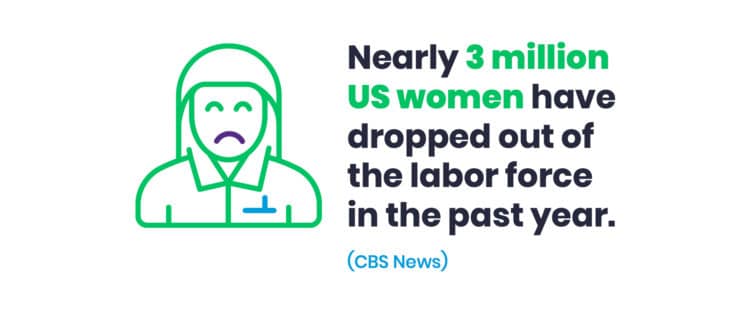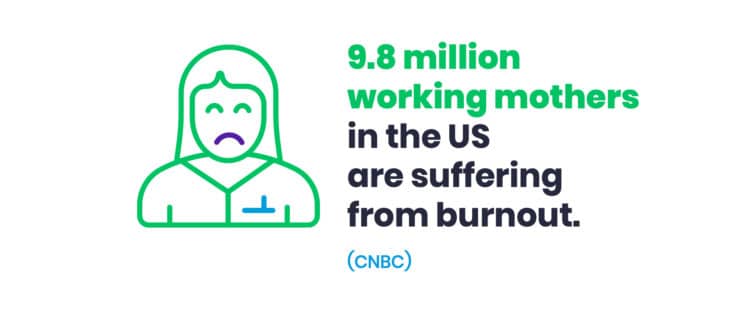Happy International Women’s Day! (And after the year we’ve had, my goodness, we deserve to be celebrated.)
The past year has been a challenging one for most. But women have been among the demographics hardest hit by the pandemic. As Fortune put it bleakly, “Women are in the fight of their lives as we run the risk of unraveling decades of progress.”
Because of this, instead of touting the achievements women have made this year, I’m choosing today to highlight the challenges modern women face and how we can be better supported moving forward.
How did we get here?
As COVID-19 continues to spread around the world, the lines between career and parenthood have become blurred. But women have disproportionately borne the brunt of e-learning demands, lack of childcare, and pandemic-induced layoffs.

For many women, the stress and anxiety of this balancing act have become too much to bear. In July, a Washington Post article titled, “Coronavirus childcare crisis will set women back a generation” reported one in four women who became unemployed during the pandemic said it was because of a lack of childcare. That’s twice the rate among men.
Today’s working mothers are burnt out, guilt-ridden, and fearful of losing their jobs. And when the dust has settled, they won’t be the only ones to suffer. Experts estimate reduced women’s employment and labor force participation rates will cost the economy anywhere from $64.5 billion to $341 billion.

For women, the struggle is real
When I asked my colleagues and fellow working moms what has been the most challenging part of working and parenting in a pandemic, they all echoed the same sentiments: unimaginable “mom guilt”, feelings of inadequacy at home and at work, and my favorite response – “what part hasn’t been challenging?”
“With everyone home, I find myself context switching even more than I used to – work, school help, snack breaks, lunch, and after school pod playdate arrangements,” said Erin Mapes, Senior UX Designer at Mediafly. “Studies show that this makes you feel more tired and frazzled and by the end of the week, I believe it! Meditation and task tracking tools have been my crutch in keeping me focused even when everything else is chaos.”
“I’m worried I’m not able to give my kids enough attention while working at home full time,” said Charlotte Powell, Creative Director at Mediafly. “I’m worried I’m not teaching them in the best ways when homeschooling (as a dyslexic creative, algebra and the ins and outs of atoms are not my bag). And I’m worried I’m not supporting them emotionally in the right ways.”
“When they’re missing friends and extended family and I’m constantly being pulled in two different directions, it’s easy for someone to snap. It took a while for me to learn to embrace my authentic self at work and not be bothered by the fact that there is a 4-year old hanging off the back of my chair while I’m on a Zoom call with my boss.”
I can empathize with Erin and Charlotte. We lost our full-time childcare due to COVID and for the first six months of lockdown, as my husband left for his essential job each morning, I was left to figure out how to keep a one and three-year old occupied while attempting a full day of work at home. (Spoiler alert: I was unsuccessful more often than not).
The stress of balancing it all had me constantly questioning if I was failing both my kids and my career. It wasn’t until we got part-time childcare back in September that I was able to finally catch my breath.
The Only Path Forward
What is currently being expected of working moms all over the world is exhausting and unsustainable. But even after the pandemic is over, it’s likely women (working or not) will continue to take on the majority of caregiving responsibilities. For working mothers to effectively manage all of our conflicting roles, we need support – not just at home but in the workplace. And when employers are willing to provide that support, everyone benefits.
“Working full-time and raising two small children is already a challenge in itself,” Laura Singer, Mediafly’s Director of Human Resources, told me of her own experience. “Couple that with a pandemic, where so many traditional outlets are off limits, and a need for more balance and flexibility for everyone involved grows. I am so appreciative that we work for an employer that empathizes when my kids have to be home due to school closures and that work might have to wait. Not everyone has that experience, but they should.”
According to Andrew Challenger, SVP of global outplacement firm Challenger, Gray & Christmas, “Unless employers can bring back or retain their women talent, future recruitment efforts, as well as future economic success, will be compromised. As you rethink your company policies and determine what the “next normal” looks like for your organization, how can you better support the working mothers you employ to create a win-win situation for everyone?
Here are some ideas:
- Offer childcare subsidies or on-site childcare services – Even before COVID, America was facing a childcare crisis. Until we fix it, the US workforce will continue hemorrhaging women. Stop prioritizing benefits like free dry-cleaning and snacks and start figuring out how to make childcare more affordable for your employees.
- Provide paid time off or sick leave – When companies don’t offer paid time off and a child gets sick, parents are forced to make a choice between their child’s health and their family’s economic security. Offering paid sick time doesn’t just create happier, more productive employees, it safeguards children’s health.
- Implement a progressive family leave policy – Research shows women who take paid family leave are 93% more likely to be in the workforce 9-12 months after their child’s birth than women who don’t. And more than 90% of companies with paid family leave policies report either a positive or neutral effect on morale, profitability, and productivity.
- Be more flexible – As kids continue to bounce from digital to in-person learning and daycares remain at reduced capacity, there are a lot of parents struggling to work a standard nine to five schedule. Flex schedules can offer moms the opportunity to get their work done when it is easiest for them. This takes some of the pressure off and ensures when they are working they can be 100% focused on the task at hand.
- Have empathy – Over the last year, the leadership team at Mediafly has been empathetic and sensitive to the needs of moms like me. Everyone I interact with at Mediafly happily chats with my sons when they pop up on Zoom calls and are understanding if I have to push a meeting because someone refuses to nap. But I know I’m lucky and not every organization is the same. Be mindful that life for most working moms is nearly impossible right now. A little grace goes a long way.
Are you looking for a role at a company that truly values their female employees? Mediafly is hiring! Check out our Careers page to learn more.

Comments are closed.